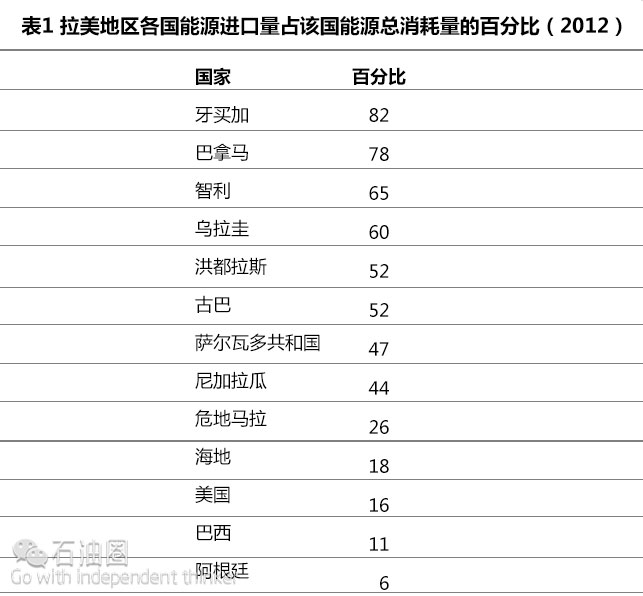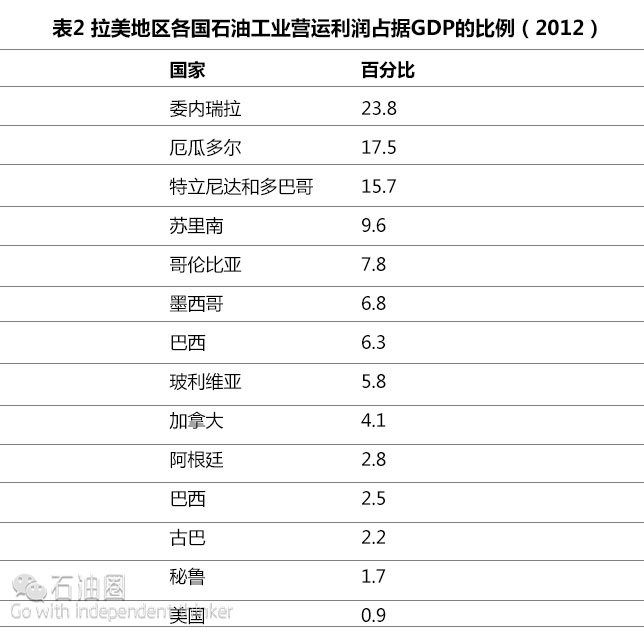
近期国际油价颓势依旧,对拉美地区各国造成了差异化的影响。该从哪些角度来研究低油价对拉美地区各国经济的影响?低油价又对拉美地区各国石油公司产生怎样的影响呢?头脑风暴走起……
拉丁美洲是指美国以南的美洲地区,包括墨西哥、中美洲、西印度群岛和南美洲。因长期曾沦为拉丁语组的西班牙和葡萄牙的殖民地,现有国家中绝大多数通行的语言属拉丁语。
拉美地区矿产资源丰富,其中石油与天然气储量尤为如此。墨西哥已探明石油储量达103亿吨,委内瑞拉的石油储量为80多亿吨,均居世界前列;拉美地区天然气已探明储量约3万亿立方米,主要分布在墨西哥和阿根廷。这些国家的油气供应成为全球石油市场的重要组成部分。然而,风云突变,国际油价在过去两年间发生剧变,从100+美元/桶一路下跌至30-美元/桶。对于那些受损最严重的石油生产国,例如哥伦比亚、厄瓜多尔、墨西哥与委内瑞拉,油价动荡对国家的经济发展、社会稳定以及政治局势都产生了强烈冲击。
现实情况更为复杂,一些能源进口大国无疑是受益匪浅,而主要的能源出口国却是深陷困境。但是对于众多能源出口国而言,通过建立多元化的经济发展模式(在某些情况下可形成对冲机制)可缓和2015~2016年间的利益受损局面。然而,委内瑞拉不幸成为石油战争“阵亡名单”中的头号输家。由于石油出口占委内瑞拉全国出口收入的95%以上、政府收入的近50%,全球油价的下跌很可能使该国出现主权债务违约甚至发生政府倒台。此外,委内瑞拉国家石油公司(PETROLEO DE VENEZUELA S.A.-PDVSA)也已陷入管理不善困境。低油价对委内瑞拉而言就是一场残酷的灾难。
我们在评估低油价对拉美地区各国所造成的影响时需要从下述三个角度出发:能源类(尤其是石油)在拉美国家经济发展体系中所占比重;国家经济发展模式对低油价冲击所产生的对冲机制;低油价对拉美地区各国石油公司所产生的影响。
低油价影响各异
拉美地区包含一些全球内典型的能源进口和能源出口国。若想考量能源类在拉美国家经济发展体系中所占比重,就需要了解特定国家的能源进口量占该国能源总消耗量的比重。表1所示的是基于世界银行2012年的相关统计数据,拉美地区各国能源进口量占该国能源总消耗量的比重。(备注:列表中缺失的拉美国家或者是能源纯出口国或者是当年未向世界银行提供相应数据)

美国与阿根廷等国作为全球主要的石油生产国均希望可以进一步提高总产量,低油价对其而言可谓是喜忧参半:国内的石油生产商利益受损,而对国内主要的能源消费者却是受益匪浅。对于加勒比海石油计划缔约国(Petrocaribe),比如萨尔瓦多、牙买加与尼加拉瓜等国,他们的石油收益将会减少,尽管这些国家在与委内瑞拉石油进口贸易中获得了融资补贴,但是他们的负债量也在以较低的速度递增着。然而,拉美地区主要的能源进口国(例如智利、巴拿马与乌拉圭)将从低油价中收益颇丰。
第二个需要考虑的方面是石油收益(石油收入减去开发成本)占据国家生产总值(以下简称GDP)的比例。表2所示是基于世界银行2012年的相关统计数据,拉美地区各国石油工业营运利润占据GDP的比例。

从上表中可以看出,一些石油生产国(例如委内瑞拉、厄瓜多尔、特立尼达与多巴哥)的GDP高度依赖于石油收益,因而受到低油价的强烈冲击。相较而言,墨西哥与哥伦比亚等石油生产国由于国内经济发展模式呈现多元化,虽然也受到低油价不利形势的冲击,但是利益受损程度要轻很多。
拉美国家能够缓和低油价冲击吗?
面对长期的油价低迷困境,石油生产国应采取怎样的措施来有效应对呢?大多数国家所产石油是以签订长期合同的方式进行销售的,其中原油价格一般遵循现货市场定价机制或是一篮子的现货市场价格(价格随产品种类不同而变化),因而所签订的合同并不能保护石油生产国免受低油价的冲击。由于石油交易支付时限可向后推迟90天,即一月份的超低油价如果不会一直持续到4月份便不会对该地区主要石油生产国的出口收益造成巨大影响。然而,鉴于油价狂跌不休,不但委内瑞拉深受重创,甚至国家经济多元化发展的墨西哥和哥伦比亚也难逃厄运。
在过去,拉美地区一些石油生产国尝试建立主权财富基金(sovereign wealth funds)来管理商品贸易繁荣带来的巨额财富,其中以智利最具代表性(主要基于铜矿出口收入)。墨西哥和哥伦比亚都建立了主权财富基金但规模较小,面对油价狂跌所带来的巨大冲击,其缓冲作用并不显著。委内瑞拉在20世纪90年代末的油价高企时期为储备部分石油收入而建立了宏观经济稳定基金。根据若干统计,如果查韦斯政府(乌戈•拉斐尔•查韦斯•弗里亚斯(Hugo Rafael Chavez Frias))能够按照基金设立之初的基本原则运营现在估计会积累数千亿美元的财富。然而,实际上,富余的石油收入主要被用于支付政府大幅增长的开支及国内消费。
所谓主权财富(Sovereign Wealth),与私人财富相对应,是指一国政府通过特定税收与预算分配、可再生自然资源收入和国际收支盈余等方式积累形成的,由政府控制与支配的,通常以外币形式持有的公共财富。传统上,主权财富管理方式非常被动保守,对本国与国际金融市场影响也非常有限。随着近年来主权财富得利于国际油价飙升和国际贸易扩张而急剧增加,主权财富基金的管理成为一个日趋重要的议题。国际上最新的发展趋势是成立主权财富基金,并设立通常独立于央行和财政部的专业投资机构管理这些基金。
墨西哥历史上曾利用国际金融市场来防备低油价冲击。墨西哥财政与公共信贷秘书处(the Secretariat of Finance and Public Credit)与国家央行(Mexico’s central bank)通力合作,每年利用金融性套期保值策略(financial hedge)以最低的石油价格锁定国家税收资金,以应对明年国际原油市场可能的动荡。例如,该国在2015年斥资7.73亿美元以76.40美元每股的价格购入石油看跌期权。然而,随着国际油价的一路下跌且长期颓势不减,如若墨西哥再采取这样的措施,所付出的代价将会更大,因而购入看跌期权来应对低油价冲击的对冲方式已经变得收益微薄。(put option,看跌期权、卖方期权、卖出(选择)权。控制实施的主动权在卖方,当股票价位跌破期权限定的价格时,期权持有者可将手中持有的股票以期权限定的价格卖出,从而使股票跌价的风险得到对冲。)
最终,该地区的石油生产国家将不得不采取削减预算支出并向国际资本市场借款,以应对低油价的冲击。哥伦比亚和墨西哥虽然都深受低油价形势影响,但是两国均可通过国外借款来弥补财政预算赤字。厄瓜多尔八年前因债务违约而被国际资本市场封杀,由于该国政府负债额度不高且宏观经济情况相对稳定,所以该国目前已经重新回归国际资本市场并获得新的融资。唯独委内瑞拉举步维艰,长达十年之久的石油繁荣过后却是负债累累。此外,由于国际社会众多投资者普遍认为该国投资风险太大,导致该国无法通过传统方式获得国际融资。尽管中国在过去的八年间共向委内瑞拉提供了500亿美元的贷款,计划于2016年新投入65亿美元带有更多的附加条件,要求追加贷款用于增加石油产量与新的采矿项目。
石油企业发展远景,任重而道远
国际油价的持续颓势给拉美地区参与石油勘探开发的众多企业造成了沉重影响。一部分运营商在石油行业繁盛时期通过贷款积极扩大生产规模,不曾想好景不长,前期的扩张转变为当下沉重的负担,其中包括负债累累的委内瑞拉和墨西哥国家石油公司,还有美国和拉美地区的一些私人石油公司。更甚者,以厄瓜多尔为例,石油开发成本本身就很高,在收益微薄的情况下也执意扩大生产规模,因为运营商要保障现金流的运转。另一方面,由于成品油价格下降速度要远小于原油,所以国家通过大力发展炼油业务可在短期内受益。从长远来看,成品油价格仍会持续下降,这无疑会给经营下游业务的企业带来财务压力。
对于石油收益占比GDP较小的非能源依赖型国家而言,国内的石油生产商仍是当地经济的主要参与者,无论是涉足股票市场还是通过与当地服务商签订合同而参与到实体经济中去。巴西国家石油公司(Petrobras)因近期内的腐败丑闻以及国际原油价格持续低迷态势的冲击,市值从2011年的3500亿美元缩减到当前的200亿美元;哥伦比亚国家石油公司(Ecopetrol)市值从2012年的640亿美元下降到当前的60多亿美元。市值的大幅缩水不仅会对投资者产生消极影响,还会导致这些公司通过出售股票来筹集资金的难度增大,进而影响新一轮的资本支出。例如,巴西石油公司不得不大幅下调投资计划,这无疑会对国家经济活动造成消极影响。当前资本支出的减少会限制国家在未来的石油生产能力。
结论
在考虑低油价对拉美地区各国所产生的影响时,需要将该区域的国家分为三类再分别展开分析:
第一类以委内瑞拉为代表。石油收益占据GDP比重很大,典型的能源依赖型国家,国家经济发展模式单一化,难以应对低油价冲击。国家经济发展惨淡,政治局势堪忧,游离在人道主义危机边缘。
第二类以巴西、哥伦比亚、厄瓜多尔和墨西哥为代表。这些国家的经济发展模式呈现多元化,可助力石油生产公司在一定程度上缓解低油价冲击。公司营收增长放缓甚至衰退将是必须面对的现实状况,但它们可以避免重大经济灾难的发生。然而,这些国家的国家石油公司遭遇着市值大幅蒸发、收入降低以及可支出资本锐减等诸多难题,可能需要数年的时间才能恢复元气。
第三类是受益于低油价的石油进口国。其中一部分国家可能会抓住这次契机来调整早前的能源政策。例如,阿根廷国内之前实行能源消费补贴政策,现在它可以适当缩减扶持力度。早前高度依赖外国补贴的国家(例如加勒比海石油计划缔约国),现在有机会实施新的能源政策,以削弱委内瑞拉等外部经济体对他们的影响。
作者/Harold Trinkunas 译者/姚圆 编辑/Wang Yue
Latin America contains some of the world’s largest reserves of oil, and key states supply an important part of the global oil market. Crude oil prices have fallen dramatically over the past two years—from over $100 per barrel to less than $30. That has focused attention on the hardest-hit large producers, such as Colombia, Ecuador, Mexico, and Venezuela, where the economic, social, and even political consequences are most dramatic.
But the reality is more mixed. Some large energy importers will undoubtedly benefit, and some large producers are in deep trouble. But for many oil producers, a combination of a diversified economy (and in some cases hedging mechanisms) will limit the damage for 2015 and 2016. It is only Venezuela—where oil rents dominate the economy, poor policy choices have proliferated, and the national oil company PDVSA has been mismanaged—that low oil prices have proved to be a catastrophe.
Three things to keep in mind as we assess the impact of low oil prices in the region are:
The role of energy, and specifically oil, in the economy of Latin American states;
The mechanisms available to states to hedge against the decline in oil prices; and
The impact of low oil prices on Latin America’s oil companies.
Oil’s varying impact
The region contains some of the most energy import-dependent economies and some of its most oil rent-dependent governments in the world. One way to think about the role of energy is to consider the role of imports in a given state’s total energy use. The following table is based on World Bank statistics for the percentage of each state’s energy use that was provided by imports in 2012 (states missing from the list are either net energy exporters or provided no data to the Bank for that year).
For countries such as the United States, a major oil producer, or Argentina, which had hoped to increase its oil production, low oil prices are a mixed blessing: They hurt domestic oil producers, but benefit major domestic energy consumers. Members of Petrocaribe such as El Salvador, Jamaica, and Nicaragua will experience fewer gains since they already benefited from subsidized financing for oil purchased from Venezuela, but they will at least accumulate debt at a slower pace. However, for major energy importers such as Chile, Panama, and Uruguay, low oil prices should be beneficial.
The second element to consider is the role of oil rents in the region’s economies. The following table draws on World Bank statistics to rank states in the Americas in terms of the percentage of their economies that is based on oil rents (oil income minus costs of production) in 2012.
As we can see from this table, some oil producers (Venezuela, Ecuador, and Trinidad and Tobago) are highly exposed to the effect of low oil prices because their GDP depends so significantly on oil rents. Other significant producers (Mexico and Colombia), are still affected by declining oil prices, but impact on GDP is more limited because oil production is only one component of a more diversified economy.
Can you hedge against low prices?
In the face of the long-term, secular decline in the price of oil, what can oil producing states do to hedge against sustained low oil prices? Most of the region’s oil production is sold via long-term contracts, but pricing is generally set by the spot market, or alternatively around a basket of spot market prices (which vary across products). So contracts do not generally protect oil producers from the impact of low prices. Since oil purchases are paid 90 days in arrears, January’s particularly low crude oil prices will not have full impact on the cash flow of the region’s major producers until April. These prices are so low that they will hit not only Venezuela hard, but also countries with more diversified economies: Mexico and Colombia.
In the past, a number of oil producers in the Americas have experimented with sovereign wealth funds to save excess rents from commodity booms, with Chile’s (based on copper export revenues) being the best known example. For oil, Mexico and Colombia both put in place sovereign wealth funds, but they are not of a scale or size to have a significant impact on buffering against the effect of declining oil prices. Venezuela implemented a macroeconomic stabilization fund in the late 1990s to save part of its oil revenues during periods of high prices. By some accounts, it would now have hundreds of billions of dollars in accumulated wealth today if the Chávez administration had operated the fund according to its founding principles. Instead, the excess income was largely spent on supporting vast increases in government spending and domestic consumption.
Mexico has historically used international financial markets to insure against low oil prices. In collaboration with Mexico’s central bank, the Secretariat of Finance and Public Credit uses a financial hedge each year to lock in state tax revenues at a minimum oil price for the subsequent year. For example, it bought put options for oil at $76.40 for 2015 at the cost of $773 million. However, now that oil prices have crashed and look to remain low in the medium term, repeating such an operation becomes increasingly expensive looking forward, and it is thus of less benefit as a hedge.
Ultimately, oil producing states in the region will have to resort to a mix of budget cuts and borrowing on international capital markets to address the impact of low crude prices. Colombia and Mexico, although both are significantly affected by low oil prices, have some ability to borrow from abroad to fund budget deficits. Ecuador, which had been cut off from international capital markets since its default eight years ago, has been able to return to the markets and secure financing because the government is not overly indebted and the macroeconomic picture has so far been relatively stable. Only Venezuela, which spent every cent from a spectacular decade-long oil boom and ended up heavily indebted, is unable to resort to traditional forms of international financing since it is considered too risky by many investors. Even China, which has lent about $50 billion to Venezuela in the past eight years, is attaching more conditions to a promised fresh injection of $6.5 billion in 2016, demanding that new funding be spent on increasing oil production and on new mining projects.
For oil companies, a long road ahead
Low oil prices will have a very significant impact on the corporations that engage in the exploration and production of oil in the Americas. Some producers are highly leveraged, due to loans taken out to expand production during the commodity boom. This is a problem both for heavily indebted state oil companies in Venezuela and Mexico and for private oil companies in the United States and in the region. Even in cases where it may not be profitable to produce oil due to high production costs, such as in Ecuador, producers have to continue pumping to generate cash. On the other hand, countries hosting major refinery operations have benefited in the short term as prices for refined products have fallen more slowly than that for crude oil. In the long term, prices for refined products are likely to fall as well, putting financial pressure on companies engaged in downstream operations.
Even in countries that are not heavily dependent on oil rents, national oil producers are major players in the local economy, both in terms of the stock markets and in the real economy through contracts to local suppliers. Brazil’s Petrobras, thanks to recent corruption scandals and low global oil prices, went from a $350 billion market cap in 2011 to $20 billion today. Colombia’s Ecopetrol fell from a market cap of $64 billion in 2012 to a little over $6 billion today. The sharp falloff in market cap not only has an impact on investors, but it also makes it more difficult for these companies to raise new money through stock sales to fund (among other things) needed capital expenditures. For example, Petrobras has had to greatly reduce planned investment, and this has had a chilling effect on economic activity throughout the economy. And reduced capital investment today means constrained oil production capacity in the future.
Conclusions
So when thinking about the impact of low oil prices on the Americas, there are three categories of states to consider:
Oil rent-dependent states that, due to poor policy choices, are unable to hedge effectively against low oil prices, principally Venezuela. Here the economic (and political) consequences will be severe and are on the brink of producing a humanitarian crisis.
Oil producers that are able to at least partially hedge against low oil prices, such as Brazil, Colombia, Ecuador, and Mexico. These countries have financial tools that enable them to mitigate the full impact of declining oil prices. However, they will experience slower growth or even recession, but they will likely avoid major economic catastrophe. However, it may take years for their domestic oil companies, especially those focused on upstream operations, to recover from shrunken market valuations, reduced income, and low capital expenditures.
Oil importers that benefit from low energy prices. Some of these states may even use this as an opportunity to correct some poor energy policy choices. For example, Argentina has subsidized domestic energy consumption, and it could now taper off this support relatively painlessly. Other countries that have been highly dependent on external subsidies, such as Petrocaribe member states, now have an opportunity to put in place new energy strategies that make them less vulnerable to external influence from Venezuela.
未经允许,不得转载本站任何文章:

 石油圈
石油圈


